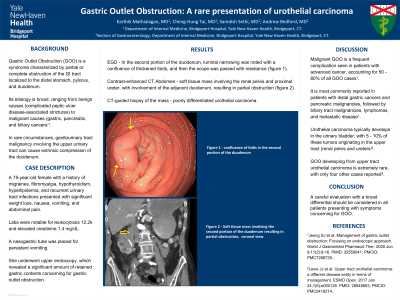Tuesday Poster Session
Category: Small Intestine
P4167 - Gastric Outlet Obstruction: A Rare Presentation of Urothelial Carcinoma
Tuesday, October 24, 2023
10:30 AM - 4:00 PM PT
Location: Exhibit Hall

Has Audio
- KM
Karthik Mathialagan, MD
Yale New Haven Health/Bridgeport Hospital
Bridgeport, CT
Presenting Author(s)
Karthik Mathialagan, MD, Cheng-Hung Tai, MD, Samdish Sethi, MD, Andrew Bedford, MD
Yale New Haven Health/Bridgeport Hospital, Bridgeport, CT
Introduction: Gastric Outlet Obstruction (GOO) is a syndrome characterized by partial or complete obstruction of the GI tract localized to the distal stomach, pylorus, and duodenum. Its etiology is broad, ranging from benign causes (complicated peptic ulcer disease-associated strictures) to malignant causes (gastric, pancreatic, and biliary cancers). In rare circumstances, genitourinary tract malignancy involving the upper urinary tract can cause extrinsic compression of the duodenum. Here, we report a case of gastric outlet obstruction from locally advanced urothelial carcinoma.
Case Description/Methods: A 75-year-old female with a history of migraines, fibromyalgia, hypothyroidism, hyperlipidemia, and recurrent urinary tract infections presented with significant weight loss, nausea, vomiting, and abdominal pain. Labs were notable for leukocytosis 12.2k and elevated creatinine 1.4 mg/dL. A nasogastric tube was placed for persistent vomiting. She underwent upper endoscopy, which revealed a significant amount of retained gastric contents concerning for gastric outlet obstruction. The scope was passed into the second portion of the duodenum, revealing a luminal narrowing in a confluence of thickened folds, and then passed with resistance (panel C). Contrast-enhanced CT of the abdomen showed a soft tissue mass involving the renal pelvis and proximal ureter, with involvement of the adjacent duodenum, resulting in partial obstruction (panels A, B). CT-guided biopsy of the mass revealed poorly differentiated urothelial carcinoma. She underwent a laparoscopic gastrojejunostomy and is currently improving on gemcitabine and carboplatin as a part of the neoadjuvant chemotherapy, according to the latest NCCN guidelines.
Discussion: Malignant GOO is a frequent complication seen in patients with advanced cancer and accounts for 50 – 80% of all GOO cases. It is most commonly reported in patients with distal gastric cancers and pancreatic malignancies, followed by biliary tract malignancies, lymphomas, and metastatic disease. Urothelial carcinoma typically develops in the urinary bladder, with 5 – 10% of these tumors originating in the upper tract (renal pelvis and ureters). GOO developing from upper tract urothelial carcinoma is extremely rare, with only four other cases reported in our literature review. A careful evaluation with a broad differential should be considered in all patients presenting with symptoms concerning for GOO.

Disclosures:
Karthik Mathialagan, MD, Cheng-Hung Tai, MD, Samdish Sethi, MD, Andrew Bedford, MD. P4167 - Gastric Outlet Obstruction: A Rare Presentation of Urothelial Carcinoma, ACG 2023 Annual Scientific Meeting Abstracts. Vancouver, BC, Canada: American College of Gastroenterology.
Yale New Haven Health/Bridgeport Hospital, Bridgeport, CT
Introduction: Gastric Outlet Obstruction (GOO) is a syndrome characterized by partial or complete obstruction of the GI tract localized to the distal stomach, pylorus, and duodenum. Its etiology is broad, ranging from benign causes (complicated peptic ulcer disease-associated strictures) to malignant causes (gastric, pancreatic, and biliary cancers). In rare circumstances, genitourinary tract malignancy involving the upper urinary tract can cause extrinsic compression of the duodenum. Here, we report a case of gastric outlet obstruction from locally advanced urothelial carcinoma.
Case Description/Methods: A 75-year-old female with a history of migraines, fibromyalgia, hypothyroidism, hyperlipidemia, and recurrent urinary tract infections presented with significant weight loss, nausea, vomiting, and abdominal pain. Labs were notable for leukocytosis 12.2k and elevated creatinine 1.4 mg/dL. A nasogastric tube was placed for persistent vomiting. She underwent upper endoscopy, which revealed a significant amount of retained gastric contents concerning for gastric outlet obstruction. The scope was passed into the second portion of the duodenum, revealing a luminal narrowing in a confluence of thickened folds, and then passed with resistance (panel C). Contrast-enhanced CT of the abdomen showed a soft tissue mass involving the renal pelvis and proximal ureter, with involvement of the adjacent duodenum, resulting in partial obstruction (panels A, B). CT-guided biopsy of the mass revealed poorly differentiated urothelial carcinoma. She underwent a laparoscopic gastrojejunostomy and is currently improving on gemcitabine and carboplatin as a part of the neoadjuvant chemotherapy, according to the latest NCCN guidelines.
Discussion: Malignant GOO is a frequent complication seen in patients with advanced cancer and accounts for 50 – 80% of all GOO cases. It is most commonly reported in patients with distal gastric cancers and pancreatic malignancies, followed by biliary tract malignancies, lymphomas, and metastatic disease. Urothelial carcinoma typically develops in the urinary bladder, with 5 – 10% of these tumors originating in the upper tract (renal pelvis and ureters). GOO developing from upper tract urothelial carcinoma is extremely rare, with only four other cases reported in our literature review. A careful evaluation with a broad differential should be considered in all patients presenting with symptoms concerning for GOO.

Figure: A - Contrast-enhanced CT Abdomen (transverse view) showing a soft tissue mass involving the second portion of the duodenum resulting in partial obstruction, marked with the arrow.
B - Contrast-enhanced CT Abdomen (coronal view) showing a soft tissue mass involving the second portion of the duodenum resulting in partial obstruction, marked with the arrow.
C- EGD showing the confluence of thickened folds in the second portion of the duodenum secondary to the extrinsic compression, marked with the arrow.
B - Contrast-enhanced CT Abdomen (coronal view) showing a soft tissue mass involving the second portion of the duodenum resulting in partial obstruction, marked with the arrow.
C- EGD showing the confluence of thickened folds in the second portion of the duodenum secondary to the extrinsic compression, marked with the arrow.
Disclosures:
Karthik Mathialagan indicated no relevant financial relationships.
Cheng-Hung Tai indicated no relevant financial relationships.
Samdish Sethi indicated no relevant financial relationships.
Andrew Bedford indicated no relevant financial relationships.
Karthik Mathialagan, MD, Cheng-Hung Tai, MD, Samdish Sethi, MD, Andrew Bedford, MD. P4167 - Gastric Outlet Obstruction: A Rare Presentation of Urothelial Carcinoma, ACG 2023 Annual Scientific Meeting Abstracts. Vancouver, BC, Canada: American College of Gastroenterology.
